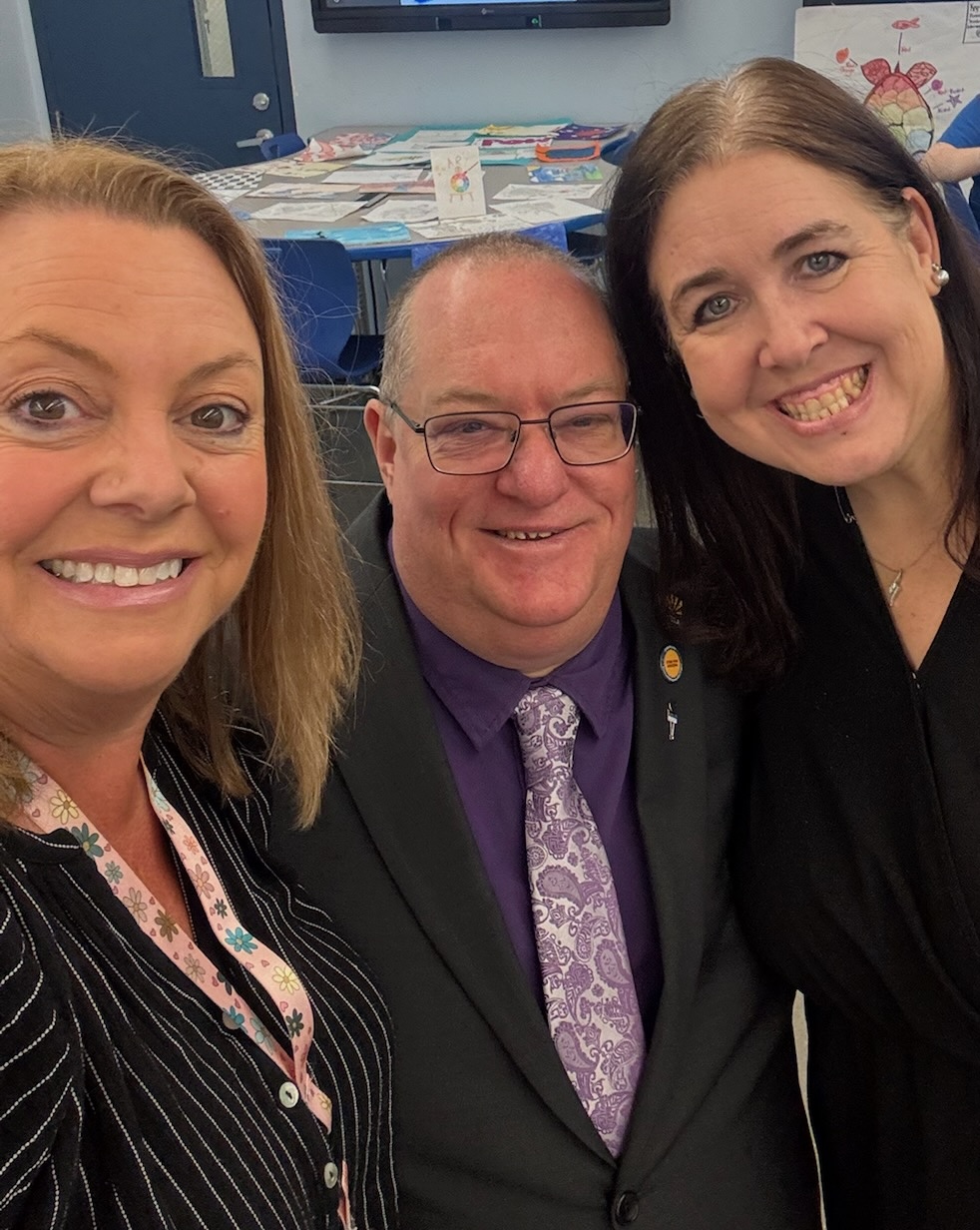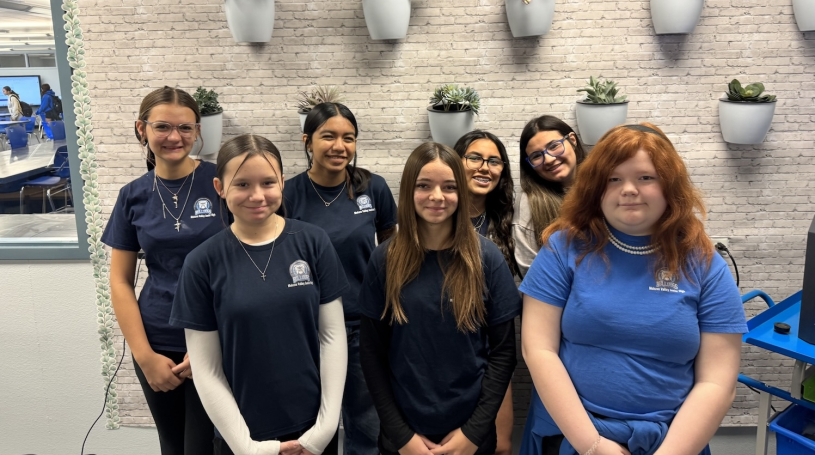Student-Led STEM and Rural School Success: Mohave Valley’s Innovation Lab
By Hailey Winkleman, ARSA Director of Communications
When you live in a rural area, creative thinking comes with the territory. Rural schools are resourceful and seek opportunities for growth, even when funding is low or nonexistent. At Mohave Valley School District, that resourcefulness has turned into improved attendance rates, better grades, and higher enrollment through their Innovation Lab project.
Mohave Valley is located in the far western part of Arizona, just two miles from the banks of the Colorado River (which also serves as the California and Nevada border). The teachers from this district describe their school as “where the sidewalk ends,” which is a common descriptor for rural schools in Arizona. The staff emphasized that field trips are a struggle because there is nothing nearby, with some ideal locations being a three to five hour drive away.
“If you look at a satellite shot of our school, there's nothing around us other than that housing area right there. That's it. The rest of it's desert,” explained David Huggins, the K-8 Innovation Coordinator and instructor for Aeronautics, Podcasting, and Broadcast Journalism.
Despite its remote location, Huggins is positive about the capabilities of Mohave Valley, and of rural schools in general:
“Rural is a battle, but it's a good battle for us. People expect us to be small and tiny and not have a lot, but that just makes us want to give them more. So we want to give them their programs that they would get elsewhere.”
This positive approach was just what Mohave Valley needed as they examined the state of their school five years ago. Chronic absenteeism was high, enrollment was dropping, and classrooms were sitting empty. Something had to change.
Thanks to a partnership with Arizona State University, the school received a Mobile STEM Lab to get the Innovation Lab started. From there, teachers wrote grants and offered their own time and resources to get the idea off the ground. With continued community support and grant writing, the program has been able to expand greatly over the course of five years, from visioning to logistics to launch.
The Innovation Lab is a flexible classroom space that hosts seven elective classes under one course title. These classes are available to all grades in the school, and during the same period, offering the most opportunities for collaboration between students and staff. This model also allows students to pursue their passion or interest, giving them voice and choice. They may decide on an area of focus, or change that focus, without going through the hassle of officially changing courses. The individual focus areas are catered to the requests of students at Mohave Valley, so they are ever-evolving.
“We wanted Innovation Lab to be a place where students could think outside the box, they could use their critical thinking skills, they could invent,” explains Pani McKenzie, instructor for 3D Printing and Invention Convention. “We wanted it to be somewhere where it was fun and it provided opportunities that other urban cities would have, but we didn't want it to be a place where they're just playing games.”
A primary goal of the Lab was to support the core curriculum while expanding opportunities for practical use. Rather than the old “sit and get” method of learning, Innovation Lab instructors translate writing into podcast scripts and math into rocket launches - making learning meaningful and relevant, aligned to student interest, and creating immediate buy-in.
“There's writing pretty much in every lesson that we do. There's math as well,” explains Mrs. McKenzie. “We meet with the core teachers, and they tell us what students need help with or what they're focusing on, and we include that in all of our lessons.”
“We strive to engage students in creative ways that make learning enjoyable,” says Holly Dennis, Graphic Design and Art Instructor. “For example, they’re practicing math concepts through art projects."
Not only do these hands-on activities help students understand core concepts, the Lab dedicates time to tracking students’ learning through authentic assessment.
“There's always an objective tied to it, and it's all STEM. It's a massive program. It's a massive undertaking,” says Mr. Huggins. “We do 15 minutes on Mondays and Wednesdays for a math program that kind of adjusts itself to their level. It gives us a lot clearer insights into where they're at so we can make adjustments.”
The choice to make the Lab a home for elective classes was also intentional; it's all about including kids, not excluding opportunities based on external measures beyond students' control.
“One of the main reasons why we do this during the day is because we are a rural school. So, they're already here. They've already made it,” says Mrs. Dennis. “A lot of our kids do not have the ability to stay after school and have someone take them home, or they have other responsibilities. This way, they’re getting it during the day when they're already required to be here.”
The impact that the availability of these courses has had on the student body was immediate and apparent:
“They want to get up and come to school because this is what they want,” explains Mr. Huggins. “So, our attendance issues have declined. We're down 12% on reducing our chronic absenteeism, and this is after reducing it last year by another 5%. So we're trending in the right direction.”
Several students also shared their thoughts about the Innovation Lab and how it’s been a benefit to their self-expression.
“For me, it's a place where you can be creative, you can meet new people, and you can feel safe to express yourself,” said Charlotte, a student in the Invention Convention course. ”There are so many courses in the Innovation Lab that fit different people, and overall it's just a really good place to be.”
“I've always been an artist, and I've always wanted to pursue art, “ said Graphic Design student Leah. “Learning that I could choose what I wanted to do made me really happy. I get to express myself through art, and I don't feel pressured to do something that I don't want to do. I've learned so much, and I feel very welcomed at this school, and I feel very seen.”
“When I first walked into Mr. Huggins’s classroom, I was really shy,” said Lola, a 3D Printing student. “He was really welcoming to me, and that kind of took me out of my shell, and now I'm really close with him and all my teachers that I have. He really pushed me out of my comfort zone and made it possible for me to be who I am today.”
Students also shared about the process of learning while developing the courses into what they want. Often, the instructors are learning right alongside their students.
“Broadcasting has definitely been a long journey for our class,” explains Brianna, a student in Broadcast Journalism. “We started off not really knowing what we're doing, including Mr. Huggins, but we all decided to work together. We all said, you know what, we're going to make this a good year, and we're going to turn journalism broadcasting into a good class.”
“I’ve learned so much about recording, and that's something I'm really interested about,” said Podcasting student Ella. “Coming in here and recording and writing scripts is something that I really enjoy.”
“I think my favorite part is when we have an idea and then we put it together, and we get so excited over it,” added Maddie, another student in Podcasting. “It just makes me happy when our idea comes to life.”
The rise in student engagement alone is a massive achievement, but the Innovation Lab’s success extends to other areas as well. Mohave Valley’s report card ranking went from a D to a B+, and it’s now just two points from an A. Three of the teachers at the district have been recognized as ARSA Teachers of Distinction, with Jennifer Van Rooy winning the Rural Teacher of the Year Award in 2024. The Innovation Lab program also received the 2023 ASBA Golden Bell Award.
“The innovation lab as a whole has changed the school drastically,” says Mr. Huggins. “It's all really good, and as the students said, it's extremely welcoming and inviting. Part of that is just because we pride ourselves on giving our kids what they want.”
“If your students are really interested in it, it's worth it,” agrees Ms. McKenzie. “You could have fun and learn along with them. Take a risk, identify a space, convert it, and then start writing grants.”
Thank you to the Mohave Valley team for taking the time to share about their Innovation Lab program. This is an incredible example of rural resilience and resourcefulness, and we hope you enjoyed learning more about it. We also look forward to hearing more about the Discovery Den initiative at Camp Mohave, focused on Innovation for grades 3-5, which will evolve the developmental profile of innovation within the Mohave Valley Elementary School District. Mohave Valley’s staff is also excited to share ideas and collaborate with other rural schools. In addition to agreeing to this interview, the staff requested that their contact information be shared with readers so they can get in touch (see below).
–

Contact Information for Mohave Valley Staff:
Charlotte Hansen - Principal - hansenc@mvdistrict.net
Michael Ingerson -Vice Principal - ingersonm@mvdistrict.net
David Huggins - MVESD K-8 Innovation Coordinator/Aeronautics/Podcasting/Broadcast Journalism - hugginsd@mvdistrict.net Cell: 725-777-9772
Pani McKenzie - 3D Printing/Invention Convention - mckenziep@mvdistrict.net
Holly Dennis - Graphic Design/Art - dennish@mvdistrict.net
–
About Arizona Rural Schools Association (ARSA):
The Arizona Rural Schools Association is a non-profit organization dedicated to supporting and advocating for rural education in Arizona. ARSA serves as a voice for rural schools, providing resources, professional development opportunities, and networking platforms to promote excellence in rural education.

